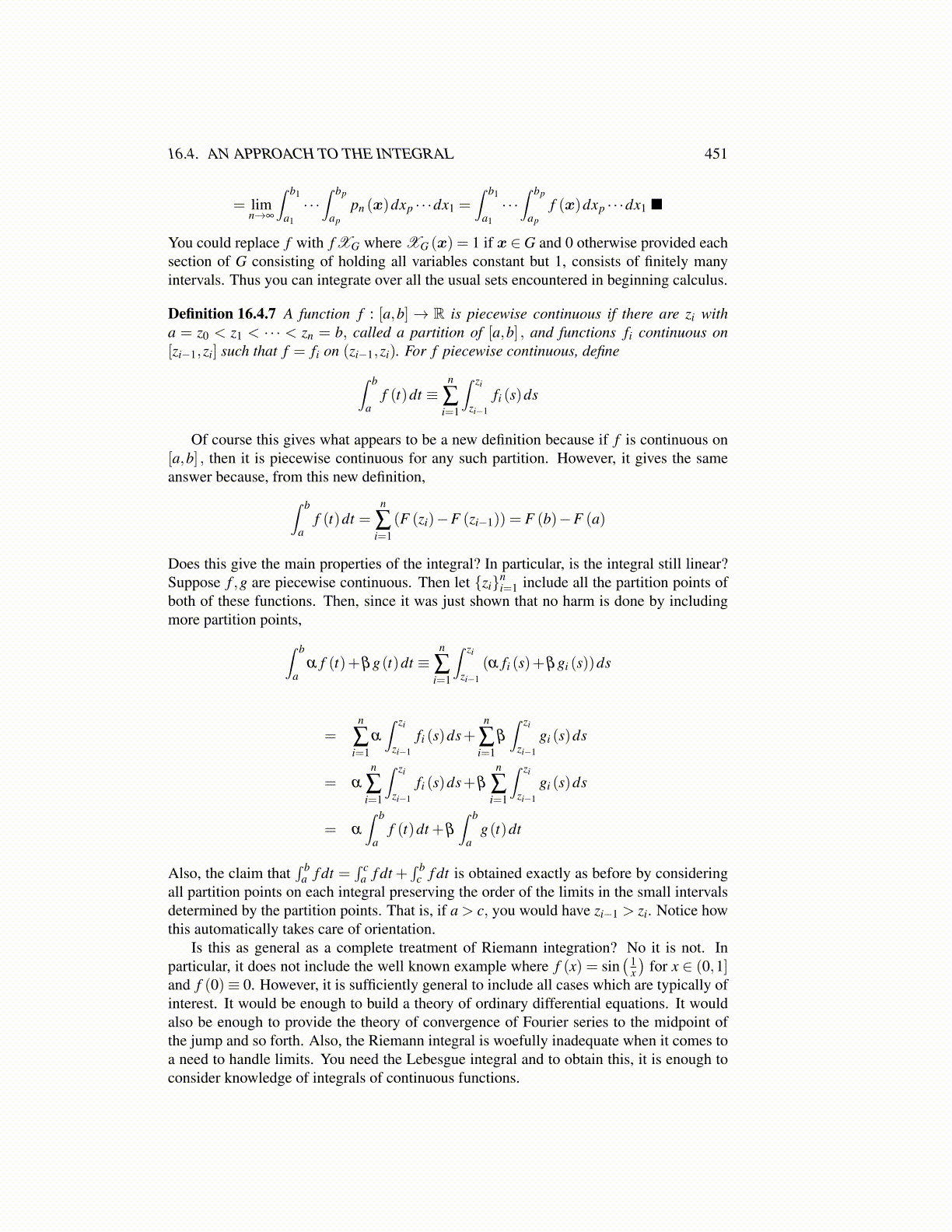
16.4. AN APPROACH TO THE INTEGRAL 451
= limn→∞
∫ b1
a1
· · ·∫ bp
ap
pn (x)dxp · · ·dx1 =∫ b1
a1
· · ·∫ bp
ap
f (x)dxp · · ·dx1 ■
You could replace f with f XG where XG (x) = 1 if x ∈ G and 0 otherwise provided eachsection of G consisting of holding all variables constant but 1, consists of finitely manyintervals. Thus you can integrate over all the usual sets encountered in beginning calculus.
Definition 16.4.7 A function f : [a,b]→ R is piecewise continuous if there are zi witha = z0 < z1 < · · · < zn = b, called a partition of [a,b] , and functions fi continuous on[zi−1,zi] such that f = fi on (zi−1,zi). For f piecewise continuous, define∫ b
af (t)dt ≡
n
∑i=1
∫ zi
zi−1
fi (s)ds
Of course this gives what appears to be a new definition because if f is continuous on[a,b] , then it is piecewise continuous for any such partition. However, it gives the sameanswer because, from this new definition,∫ b
af (t)dt =
n
∑i=1
(F (zi)−F (zi−1)) = F (b)−F (a)
Does this give the main properties of the integral? In particular, is the integral still linear?Suppose f ,g are piecewise continuous. Then let {zi}n
i=1 include all the partition points ofboth of these functions. Then, since it was just shown that no harm is done by includingmore partition points,∫ b
aα f (t)+βg(t)dt ≡
n
∑i=1
∫ zi
zi−1
(α fi (s)+βgi (s))ds
=n
∑i=1
α
∫ zi
zi−1
fi (s)ds+n
∑i=1
β
∫ zi
zi−1
gi (s)ds
= α
n
∑i=1
∫ zi
zi−1
fi (s)ds+β
n
∑i=1
∫ zi
zi−1
gi (s)ds
= α
∫ b
af (t)dt +β
∫ b
ag(t)dt
Also, the claim that∫ b
a f dt =∫ c
a f dt +∫ b
c f dt is obtained exactly as before by consideringall partition points on each integral preserving the order of the limits in the small intervalsdetermined by the partition points. That is, if a > c, you would have zi−1 > zi. Notice howthis automatically takes care of orientation.
Is this as general as a complete treatment of Riemann integration? No it is not. Inparticular, it does not include the well known example where f (x) = sin
( 1x
)for x ∈ (0,1]
and f (0)≡ 0. However, it is sufficiently general to include all cases which are typically ofinterest. It would be enough to build a theory of ordinary differential equations. It wouldalso be enough to provide the theory of convergence of Fourier series to the midpoint ofthe jump and so forth. Also, the Riemann integral is woefully inadequate when it comes toa need to handle limits. You need the Lebesgue integral and to obtain this, it is enough toconsider knowledge of integrals of continuous functions.